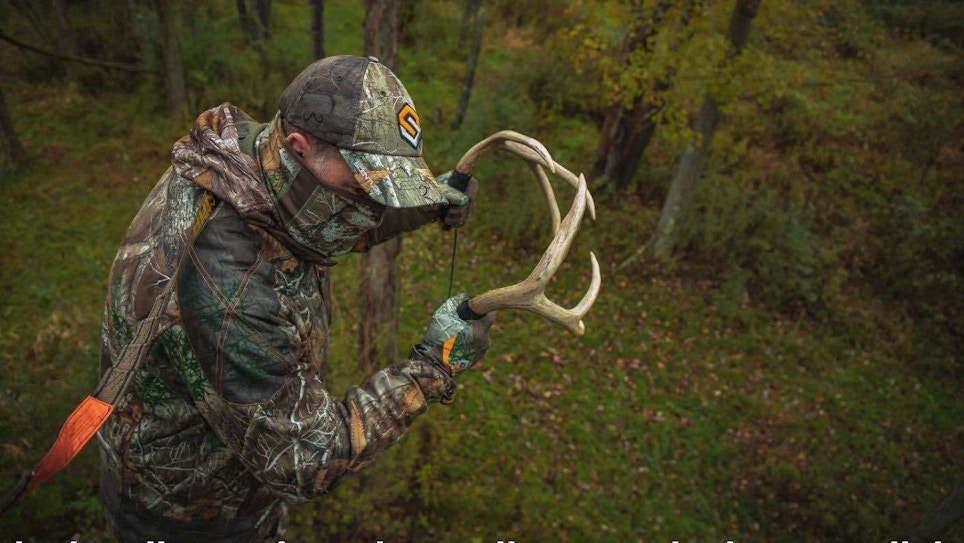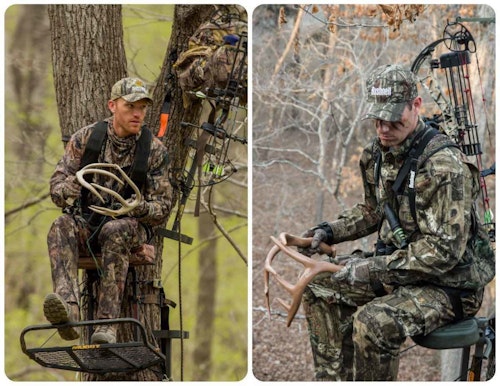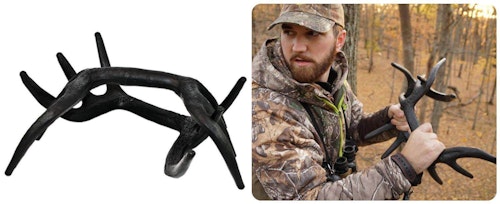While rattling for whitetails isn’t a foolproof method, it’s a technique that can work well when conditions are right. The purpose of this article isn’t to break down why, when and how to rattle; I’ll cover those topics in a follow-up post. Rather, I want to explain the pros and cons of real vs. fake antlers based on my 45 years of deer hunting experience.
Real Antlers
Deer hunters who want to rattle with real antlers can get them off the head of a killed buck or use fresh sheds. By “fresh” I mean antlers that aren’t chalky and porous. Ideally, they should look identical to antlers you’d see on a living buck. Don’t misunderstand me: The sheds don’t have to be so fresh there’s still blood on the antler base when you find them in the field. As long as they haven’t been exposed to sun and moisture for several months, they should work fine.
Antler color isn’t critical. Some bucks have whitish racks and others are nearly chocolate brown; most are somewhere in the middle. The key is the antlers must be rock hard. It’s the antler hardness, as well as antler mass (more on that later), that contributes to best rattling sound.
You probably won’t find both shed antlers from a single buck. If you do, that’s great because they’ll likely mesh well for rattling vs. two mismatched antlers that are quite different in size, shape and number of points. I’ve successfully rattled in whitetails with matched sheds, matched antlers from a killed buck, mismatched antlers from two killed bucks, and mismatched sheds. In fact, my favorite set of rattling antlers was given to me by a college friend 35 years ago; it consists of one whitetail shed (2.5-year-old buck), paired with a similar-sized muley shed. As I said previously, it’s the sound that matters, and these mismatched sheds mesh together well and sound great.
Antler mass contributes greatly to the rattling sound. Not only can you generate more volume with larger/thicker antlers, but the sound is deeper, too. No matter how hard you try, you can’t generate much volume smashing together the thin antlers from a 1.5-year-old 3x3 buck. Your rattling sequence will sound like two adult bucks tickling their antlers — simple sparring. If you want to mimic two mature bucks in a knock-down, drag-out fight over a hot doe, you’d better have antlers with some heft.
Of course, the downside to using large antlers for rattling is transporting them in the field. They sound great from your treestand, but you have to carry them to the base of your stand, then get them 15 to 20 feet in the air.
I choose the real rattling antlers I described earlier (mid-sized whitetail and muley sheds) because they’re a smart compromise. They fit in my daypack but have enough heft to mimic the sound of two decent-sized bucks fighting. I also have them rigged on a bungee cord (see photo below) so I can carry them around my waist using the bungee like a belt. Do they generate the noise of two Booners battling to the death? No. But on the properties I hunt, I’m pursuing bucks from 2.5 to 3.5 years old, ones scoring 120 to 150 points.

Rattling Bag Systems
A convenient rattling system to carry in the field is a rattling bag because it fits easily into a daypack. Rattling bags such as a Primos Big Bucks Rattling Bag ($13.99), Hunters Specialties Ruttin’ Buck Rattling Bag ($9.99) and Flextone Rubber-Flex Battle Bag Plus ($18.99) work well for mimicking the sound of sparring bucks, and for that reason you should consider carrying one during September and early October. Mature bucks aren’t fighting over a hot doe during these periods; instead, they’re still sorting out dominance. There’s no reason to carry bulkier antlers in the field during this time because all you should be doing in terms of rattling is tickling together the antler tines. You can duplicate this “light” sound with a rattling bag and it’s so much easier to transport than real antlers.
The primary downside to a rattling bag is you can’t generate the volume and deep sound to mimic two mature bucks fighting over a hot doe. No matter how hard you try, it’s simply not possible. For that reason, a rattling bag wouldn’t be my first choice during the rut.
One final note: A rattling bag, because of its design (loose polymer sticks in a pouch), can make unwanted sounds during transportation unless you stretch a strong rubber band tightly over the sticks.
Fake Antlers
Some hunters prefer to carry fake antlers such as Illusion Systems Black Rack ($24.99; below), Flextone Battle Bones ($24.99) and Primos Fightin’ Horns ($22.99). In my experience, you can generate nearly the same volume and deep sound with fake antlers as you can with real antlers. Notice I said “nearly.” Again, it all comes down to size. No company offers imitations that can compete with a set of thick antlers from a 170-class 5.5-year-old buck. However, if you’re like me and want to mimic the sound of two 2.5- or 3.5-year-old bucks, then fake antlers will do the job nicely.
Of course, one benefit to fake antlers is you simply purchase them. You don’t have to look for sheds or cut antlers from a dead buck. Another advantage to fake antlers is they’re manufactured to mesh perfectly; they’re easy to use because of the design.
A Unique Option
One rattling system that doesn’t fit the categories above is the Knight and Hale Pack Rack ($14.99). This device is compact like a rattling bag but works by twisting/hammering two pieces of durable high-density plastic against each other.
I’ve owned a Pack Rack for at least two decades and it almost has a permanent home in my daypack. The only time I remove it is during the rut when I’m carrying a set of real antlers for more volume and deeper sound. The Pack Rack does a good job of mimicking sparring bucks.
I prefer the Pack Rack over a rattling bag because in my opinion it sounds more authentic. It’s also 100 percent quiet when not in use because the two parts fit together tightly (see note above about keeping a rattling bag silent).
Final Thoughts
I know that the marketing copy for all the rattling systems I’ve described here claim that product X can produce the extreme-volume antler sounds of two mature bucks fighting to the death. That’s true for larger fake antlers, but in my experience it isn’t the case with rattling bags and the Pack Rack.
I don’t think whitetail bucks can tell the difference between real antlers and top-notch fake ones — including rattling bags and the Pack Rack to mimic light sparring. The compact imitations have some advantages, and that’s why I depend on a combination of real antlers and fakes.
Check out the 1-minute video below to see a Primos Rattling Bag and Pack Rack in action. At the start, the host rattles with two large sheds. Keep in mind he’s not holding the sheds tightly, and he’s not attempting to make booming sounds with them. Viewing suggestion: Turn your head away from your phone or laptop and listen to the full video and compare the sounds of the large sheds vs. the Rattling Bag vs. the Pack Rack.










